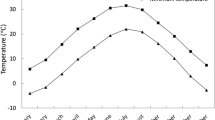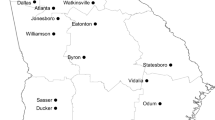Abstract
The Olympic Games will be held in Tokyo in 2020 and the period will be the hottest period of the year in Japan. Marathon is a sport with a large heat load, and it is said that the risk of heat stroke rises more than other sports activities. The thermal environment of the 2020 Tokyo Olympic marathon course is analyzed by using wet-bulb globe temperature (WBGT) and Universal Thermal Climate Index (UTCI) map of the center area of Tokyo. The change due to the place, the effect of the shadow of the building, and the position on the course was analyzed from the distribution of WBGT and UTCI in the short-term analysis of sunny day from August 2 to August 6, 2014. To make the distribution map, we calculated distributions of sky view factor and mean radiant temperature of the 10 km × 7.5 km analyzed area in the center of Tokyo. Distributions of air temperature and humidity are calculated from Metropolitan Environmental Temperature and Rainfall Observation System data, which is a high-resolution measurement network. It was possible to incorporate the local variation of temperature and humidity of the analyzed area. In the result, the WBGT is about 1 °C lower and the UTCI is about 4–8 °C lower in the shadow of buildings from 9:00 to 10:00 than in the sunny side. As a cooling method, making a shadow is a relatively effective method. The variation along the course considering the distribution of meteorological data within the area is about 0.5 °C WBGT and 1 °C UTCI range. If we allow the error of this range, one-point meteorological data can be applied for the estimation along the course. Passing the right side (left side in the case of return) of the course could keep the accumulated value slightly lower along the course in the morning because the marathon course roughly runs from west to east and buildings’ shadow is on the relatively right side (south side). But practically, the effect of changing the position on the course was small. The long-term analysis on the degree of risk for each hour was also carried out by using one-point data of the first 10 days of August from 2007 to 2016. The risk increased rapidly after 8:00. It will be safer if the marathon race is finished before 9:00 or if the race is held after 19:00.











Similar content being viewed by others
References
Asayama M (2009) Guideline for the prevention of heat disorder in Japan. Global Environ Res 13(1):19–25
Bergeron MF, Bahr R, Bärtsch P, Bourdon L, Calbet JAL, Carlsen KH et al (2012) International Olympic Committee consensus statement on thermoregulatory and altitude challenges for high-level athletes. Br J Sports Med 46(11):770–779. https://doi.org/10.1136/bjsports-2012-091296
Brocherie F, Millet GP (2015) Is the Wet-Bulb Globe Temperature (WBGT) Index relevant for exercise in the heat? Sports Med 45(11):1619–1621. https://doi.org/10.1007/s40279-015-0386-8
Bröde, P., Fiala, D., Błażejczyk, K., Holmér, I., Jendritzky, G., Kampmann, B., … Havenith, G. (2012) Deriving the operational procedure for the Universal Thermal Climate Index (UTCI). Int J Biometeorol, 56(3), 481–494
Budd GM (2008) Wet-Bulb Globe Temperature (WBGT)—its history and its limitations. J Sci Med Sport 11(1):20–32. https://doi.org/10.1016/j.jsams.2007.07.003
D’Ambrosio Alfano FR, Malchaire J, Palella BI, Riccio G (2014) WBGT index revisited after 60 years of use. Ann Occup Hyg 58(8):955–970. https://doi.org/10.1093/annhyg/meu050
Honjo T (2009) Thermal comfort in outdoor environment. Glob Environ Res 13(2009):43–47
Honjo T, Yamato H, Mikami T, Grimmond CSB (2015) Network optimization for enhanced resilience of urban heat island measurements. Sustain Cities Soc 19:319–330. https://doi.org/10.1016/j.scs.2015.02.004
Jendritzky G, de Dear R, Havenith G (2012) UTCI—why another thermal index? Int J Biometeorol 56(3):421–428. https://doi.org/10.1007/s00484-011-0513-7
Kashimura O, Minami K, Hoshi A (2016) Prediction of WBGT for the Tokyo 2020 Olympic Marathon. Jpn. J. Biometeor 53(4):139–144. https://doi.org/10.11227/seikisho.53.139
Lindberg F, Holmer B, Thorsson S (2008) SOLWEIG 1.0—modelling spatial variations of 3D radiant fluxes and mean radiant temperature in complex urban settings. Int J Biometeorol 52(7):697–713. https://doi.org/10.1007/s00484-008-0162-7
Mikami T, Ando H, Morishima W, Izumi T, & Shioda T (2003) A new urban heat island monitoring system in Tokyo. Fifth International Conference on Urban Climate, Lodz, Poland, 1–5 September 2003. http://meteo.geo.uni.lodz.pl/icuc5/text/O_3_5.pdf
Mikami T, Yamato H, Extended-METROS Research Group (2011) High-resolution temperature observations using extended-METROS in the Tokyo metropolitan area and their urban climatological significance. J Geogr (Chigaku Zasshi) 120(2):317–324 (in Japanese with English abstract)
Mountjoy M, Alonso JM, Bergeron MF, Dvorak J, Miller S, Migliorini S (2012) Hyperthermic-related challenges in aquatics, athletics, football, tennis and triathlon. Br J Sports Med 46(11):800–804
Ohashi Y, Ihara T, Kikegawa Y, Sugiyama N (2016) Numerical simulations of influence of heat island countermeasures on outdoor human heat stress in the 23 wards of Tokyo, Japan. Energ Buildings 114:104–111. https://doi.org/10.1016/j.enbuild.2015.06.027
Okada M, Kusaka H (2013) Proposal of a new equation to estimate globe temperature in an urban park environment. J Agric Meteorol 69(1):23–32
Parsons K (2006) Heat stress standard ISO 7243 and its global application. Ind Health 44:368–379. https://doi.org/10.2486/indhealth.44.368
Racinais S, Alonso JM, Coutts AJ, Flouris AD, Girard O, González-Alonso J, Hausswirth C, Jay O, Lee JKW, Mitchell N, Nassis GP, Nybo L, Pluim BM, Roelands B, Sawka MN, Wingo J, Périard JD (2015) Consensus recommendations on training and competing in the heat. Sports Med 45(7):925–938. https://doi.org/10.1007/s40279-015-0343-6
Roberts WO (2010) Determining a “do not start” temperature for a marathon on the basis of adverse outcomes. Med Sci Sports Exerc 42(2):226–232. https://doi.org/10.1249/MSS.0b013e3181b1cdcf
Smith, K. R., Woodward, A., Lemke, B., Otto, M., Chang, C. J., Mance, A. A., … Kjellstrom, T. (2016) The last summer Olympics? Climate change, health, and work outdoors. Lancet, 388(10045), 642–644. https://doi.org/10.1016/S0140-6736(16)31335-6
Thorsson S, Rocklöv J, Konarska J, Lindberg F, Holmer B, Dousset B, Rayner D (2014) Mean radiant temperature—a predictor of heat related mortality. Urban Climate 10:332–345
Yamasaki, Y., Tsunematsu, N., Yokoyama, Umeki, K., & Honjo, T. (2016). Prediction of thermal environment in Olympic marathon course by thermal comfort map. Papers on Environmental Information Science 30:43–48. https://doi.org/10.11492/ceispapers.ceis30.0_43
Author information
Authors and Affiliations
Corresponding author
Rights and permissions
About this article
Cite this article
Honjo, T., Seo, Y., Yamasaki, Y. et al. Thermal comfort along the marathon course of the 2020 Tokyo Olympics. Int J Biometeorol 62, 1407–1419 (2018). https://doi.org/10.1007/s00484-018-1539-x
Received:
Revised:
Accepted:
Published:
Issue Date:
DOI: https://doi.org/10.1007/s00484-018-1539-x




